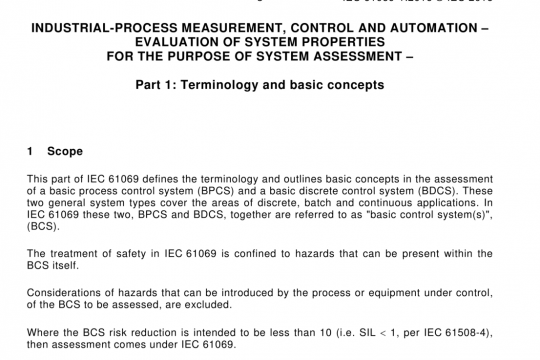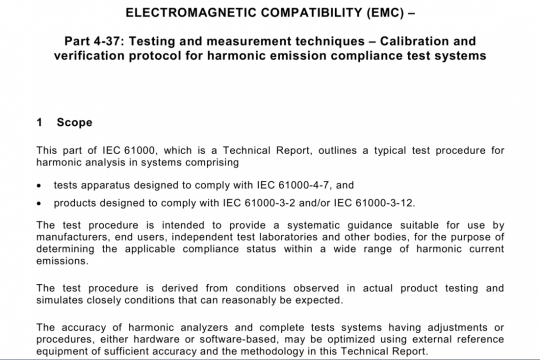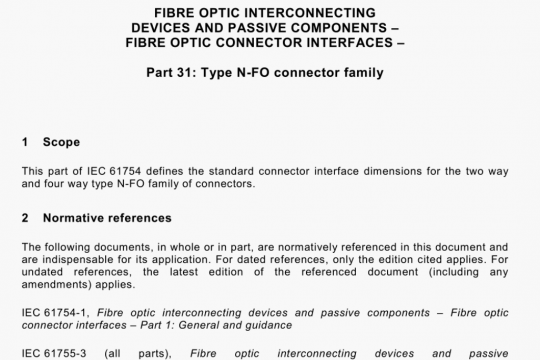BS IEC 61097-2 pdf free download
BS IEC 61097-2 pdf free download.Global maritime distress and safety system (GMDSS) Part 2: Cospas-Sarsat EPIRB一Emergency position indicating radio beacon operating on 406 MHz一Operational and performance requirements, methods of testing and required test results.
(A.694(17)/1.2) Where a unit of equipment provides a facility which is additional to the minimum requirements of this document, such as return link service (RLS) functionality or the possibility of connecting external navigation data, the operation, and as far as is reasonably practicable, the malfunction of such additional facility shall not degrade the performance of the equipment below those minimum standards. The additional facility shall, as a minimum, meet the appropriate requirements of IEC 60945, as applicable. Where such an additional facility exists, it shall not prevent the EPIRB fully conforming to the requirements of this document during normal combined operation. Any internal or external navigation device connected to, or forming part of, the EPIRB shall comply with the requirements of Annex B. Any EPIRB with optional RLS functionality shall comply with the appropriate requirements of C/S T.001 or C/S T.018 as applicable and 5.8.
The EPIRB shall be a single integral unit. No part of it shall be detachable without the use of tools.
The EPIRB shall (MSC.471(101)/A.2.3.11) be provided with a low-duty cycle white light (of at least effective 0,75 cd) active during darkness and all other lighting conditions, visible to the human eye and flashing at a rate of 20 to 30 times per minute, with a flash duration of between 10-6 s and 10-1 s for the operating lifetime of the EPIRB to indicate its position for the nearby survivors and rescue units.
This light shall be mounted so that it produces effective 0,75 cd or greater over as great a portion of the upper hemisphere as is practical. The arithmetic mean of the light output over the entire upper hemisphere shall not be less than effective 0,50 Cd. No measured points (see Table 2) shall have an effective luminous intensity of less than 0,2 cd.
NOTE 1 There can be areas of lower intensity at non measured points around the EPIRB and as the elevation increases to allow for mounting bushes, controls and the antenna, etc. and for the fact that, at higher elevation angles, the range to rescue units is reduced.
The EPIRB shall (MSC.471(101)/A.2.3.11) be provided with a low-duty cycle light active during all lighting conditions detectable by all types of night vision devices for the operating lifetime of the EPIRB.
The night vision low-duty cycle light shall have a dominant wavelength between 770 nm to 890 nm and shall have an average radiant intensity of at least 2,5 mW/sr, flashing at a rate of 20 to 30 times per minute, with a flash duration between 66 ms and 500 ms for the operating lifetime of the EPIRB.
This night vision low-duty cycle light shall be mounted so that it produces light output over as great a portion of the upper hemisphere as is practical. The arithmetic mean of the light output over the upper hemisphere above 20° elevation shall not be less than 2,5 mW/sr. No measured points (see Table 3) shall have a radiant intensity of less than 0,25 mW/sr.
NOTE 2 There can be areas of lower intensity at non measured points around the EPIRB and as the elevation increases to allow for mounting bushes, controls and the antenna, etc. and for the fact that at higher elevation angles the range to rescue units is reduced.
The flashes of the low-duty cycle white light and the low-duty cycle night vision light may be synchronous or asynchronous with respect to each other. The low-duty cycle white light and the low-duty cycle night vision light may be a combined light, provided all the conditions in h) and i) are complied with.
The EPIRB shall (MSC.471(1O1)/A.2.3.14) be provided with a 121,5 MHz beacon primarily for homing by aircraft.
The EPIRB shall (MSC.471(101)/A.2.3.15) be provided with an internal GNSS receiver for position fixes and an associated indication that GNSS signal reception is satisfactory or unsatisfactory.
The EPIRB shall (MSC.471(101)/A.2.3.16) be provided with an automatic identification system (AIS) locating signal in accordance with the Recommendation ITU-R M. 1371, Technical characteristics for an automatic identification system using time division multiple access in the VHF maritime mobile frequency band.
The EPIRB should have an exterior design that precludes sharp edges to prevent damage to inflatable survival craft.BS IEC 61097-2 pdf download.




